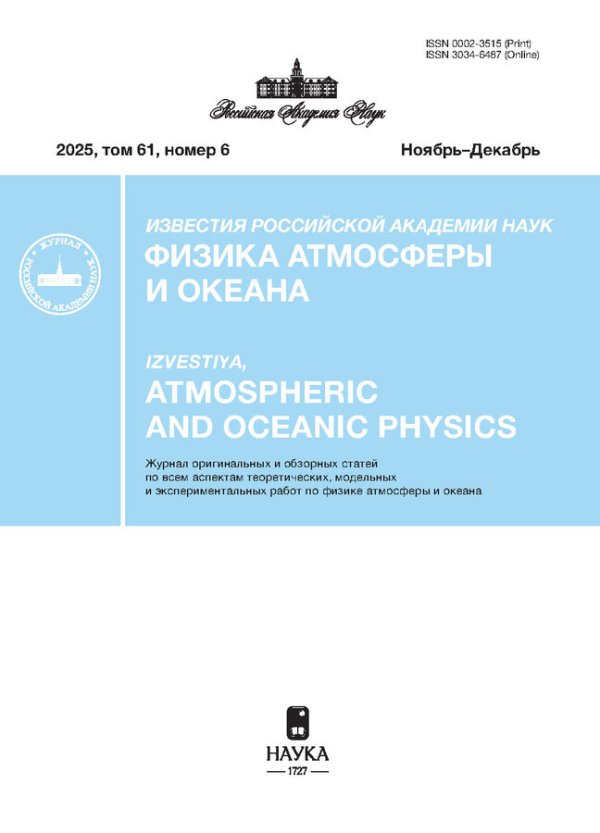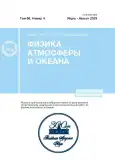Водяные смерчи в России и в мире: климатология и условия возникновения
- Авторы: Калмыкова О.В.1
-
Учреждения:
- ФГБУ “Научно-производственное объединение “Тайфун”
- Выпуск: Том 59, № 4 (2023)
- Страницы: 421-436
- Раздел: Статьи
- URL: https://journals.rcsi.science/0002-3515/article/view/136925
- DOI: https://doi.org/10.31857/S0002351523040107
- EDN: https://elibrary.ru/YOBSZW
- ID: 136925
Цитировать
Полный текст
Аннотация
Представлен обзор изученности водяных смерчей в мире. Приведены наиболее известные схематические модели образования водяных смерчей. Выделены основные факторы смерчегенеза над водной поверхностью. Собраны и проанализированы данные о случаях регистрации водяных смерчей на земном шаре за период с 2000 по 2022 гг. Выделены три основных района их сосредоточения: Средиземное море, Мексиканский залив и прилегающая Атлантика, Великие американские озера. Оценена повторяемость водяных смерчей в странах с наибольшим числом случаев их ежегодной регистрации (США, Италия, Греция, Россия, Турция). Обобщены известные данные о характеристиках смерчей, полученные в ходе прямых и дистанционных измерений. Дана концептуальная схема их строения. Проанализированы водяные смерчи в России. Представлена статистика случаев их регистрации у Черноморского побережья России. Построена карта мест выхода черноморских смерчей на побережье.
Об авторах
О. В. Калмыкова
ФГБУ “Научно-производственное объединение “Тайфун”
Автор, ответственный за переписку.
Email: kov@feerc.ru
Россия, 249038, Обнинск, ул. Победы, 4
Список литературы
- Алексеенко C.В., Куйбин П.А., Окулов В.Л. Введение в теорию концентрированных вихрей. Новосибирск: Институт теплофизики СО РАН, 2003. 503 с.
- Калмыкова О.В. Методика оценки смерчеопасности вблизи Черноморского побережья России и результаты ее испытаний // Информационный сборник “Результаты испытания новых и усовершенствованных технологий, моделей и методов гидрометеорологических прогнозов”. 2021. № 48. С. 42–61.
- Калмыкова О.В. Смерчи над Черным морем – новая визитная карточка юга России // Закономерности формирования и воздействия морских, атмосферных опасных явлений и катастроф на прибрежную зону РФ в условиях глобальных климатических и индустриальных вызовов (“Опасные явления – III”). 15–19 июня 2021 г. Материалы международной научной конференции. Ростов-на-Дону, 2021. С. 73–77.
- Нестеров Е.С. Экстремальные циклоны над морями европейской части России // Гидрометеорологические исследования и прогнозы. 2018. № 1(367). С. 97–115.
- Павлов Н.И., Замышляев С.В. Смерчи Приморского края и их возможная интенсификация в период глобального антропогенного потепления климата // Труды Дальневосточного государственного технического университета. 2003. № 133. С. 145–151.
- Попов В.Б., Синькевич А.А., Янг Дж., Михайловский Ю.П., Торопова М.Л., Довгалюк Ю.А., Веремей Н.Е., Старых Д.С. Характеристики и структура кучево-дождевого облака с водяным смерчем над Финским заливом // Метеорология и гидрология. 2020. № 9. С. 5–16.
- Синькевич А.А., Попов В.Б., Михайловский Ю.П., Торопова М.Л., Довгалюк Ю.А., Веремей Н.Е., Старых Д.С. Характеристики кучево-дождевого облака с водяным смерчем над Ладожским озером по данным дистанционных измерений // Оптика атмосферы и океана. 2020. Т. 33. № 2. С. 153–158.
- Смерч пронесся по берегу озера Байкал – https://www.1tv. ru/news/2021-01-06/399568-smerch_pronessya_po_beregu_ozera_baykal
- Снитковский А.И. Смерчи на территории СССР // Метеорология и гидрология. 1987. № 9. С. 12–25.
- Ткаченко Ю.Ю., Денисов В.И., Перов Е.А. Морские водяные смерчи на Черноморском побережье Краснодарского края, наблюдение, прогнозирование // Экология, экономика, информатика. Серия: Геоинформационные технологии и космический мониторинг. 2019. № 4. С. 164–170.
- Чернокульский А.В., Курганский М.В., Мохов И.И., Шихов А.Н., Ажигов И.О., Селезнева Е.В., Захарченко Д.И., Антонеску Б., Кюне Т. Смерчи в российских регионах // Метеорология и гидрология. 2021. № 2. С. 17–34.
- Шнюков Е.Ф., Митин Л.И., Цемко В.П. Катастрофы в Черном море. Киев: Манускрипт, 1994. 296 с.
- A week-long ‘waterspout outbreak’ produced a record 232 funnels over the Great Lakes – https://www.washingtonpost.com/weather/2020/10/06/great-lakes-waterspout-outbreak/.
- Brady R.H., Szoke E.J. A Case Study of Nonmesocyclone Tornado Development in Northeast Colorado: Similarities to Waterspout Formation // Monthly Weather Review. 1989. V. 117. P. 843–856.
- Chan P.W., Hon K.K., Robinson P., Kosiba K., Wurman J., Li Q.S. Analysis and numerical simulation of a supercell tornado at the Hong Kong adjacent waters // Meteorological Applications. 2022. V. 29. 17 p.
- Dotzek N., Emeis S., Lefebvre C., Gerpott J. Waterspouts over the North and Baltic Seas: Observations and climatology, prediction and reporting // Meteorologische Zeitschrift. 2010. V. 19. № 1. P. 115–129.
- Glanville M.J., Rohr C.J., Holmes J.D. Tornadic Waterspout Impacts on Coastal Australia // 18th Australasian Wind Engineering Society Workshop: preprints. McLaren Vale (South Australia). 2016. 4 p.
- Golden J.H. An Assessment of Waterspout Frequencies along the U. S. East and Gulf Coasts // Journal of Applied Meteorology. 1977. V. 16. P. 231–236.
- Golden J.H. Scale-Interaction Implication for the Waterspout Life Cycle. II // J. Applied Meteorology. 1974. V. 13. № 6. P. 693–709.
- Golden, J.H. The Life Cycle of Florida Keys Waterspouts. I // J. Applied Meteorology. 1974. V. 13. № 6. P. 676–692.
- Golden J.H. The Lower Florida Keys Waterspout Project, May-September 1969 // Bulletin American Meteorological Society. 1970. V. 51. № 3. P. 235–236.
- Golden J.H. Waterspouts / Encyclopedia of Atmospheric Sciences: Editor-in-Chief J.R. Holton, second edition, volume 3. N.Y.: Academic Press, 2015. P. 369–383.
- Golden J.H. Waterspouts and Tornadoes over South Florida // Monthly Weather Review. 1971. V. 99. № 2. P. 146–154.
- Golden J.H., Bluestein H.B. The NOAA-National Geographic Society Waterspout Expedition (1993) // Bulletin American Meteorological Society. 1994. V. 75. № 12. P. 2281–2288.
- Leverson V.H., Sinclair P.C. Waterspout Wind, Temperature and Pressure Structure Deduced from Aircraft Measurements // Monthly Weather Review. 1977. V. 105. P. 725–733.
- Markowski P.M., Richardson Y.P. Mesoscale Meteorology in Midlatitudes. New Jersey: Willey, 2010. 407 p.
- Meaden G.T. The Classification of Whirlwind Types and a Discussion of Their Physical Origins // Proceedings of the First Conference on Tornadoes, Waterspouts, Wind-Devils and Severe Storm Phenomena. The J. Meteorology. Oxford Polytechnic. 29th June 1985. P. 194–202.
- Miglietta M.M. Waterspouts: A Review // Reference Module in Earth Systems and Environmental Sciences. 2019. 15 p.
- Miglietta M.M., Matsangouras I. An updated “climatology” of tornadoes and waterspouts in Italy // International J. Climatology. 2018. V. 38. P. 3667–3683.
- Mihajlovic J., Buric D., Ducic V., Milenkovic M. Synoptic characteristics of an Extreme Weather Event: The Tornadic Waterspout in Tivat (Montenegro), on June 9, 2018 // Geographia Polonica. 2021. V. 94. P. 69–90.
- Renko T., Kuzmic J., Soljan V., Mahovic N.S. Waterspouts in the Eastern Adriatic from 2001 to 2013 // Natural Hazards. 2016. V. 82. P. 441–470.
- Renno N.O., Bluestein H.B. A Simple Theory for Waterspouts // American Meteorological Society. 2001. V. 58. P. 927–932.
- Rossow V.J. Observations of waterspouts and their parent cloud // NASA Technical Note. 1970. 63 p.
- Samaras T.M. A historical perspective of In-Situ observations within Tornado Cores // 22nd Conference on Severe Local Storms: preprints. Hyannis (Massachusetts, USA). 2004. 11 p.
- Schwiesow R.L. Horizontal Velocity Structure in Waterspouts // J. Applied Meteorology. 1981. V. 20. P. 349–360.
- Schwiesow R.L., Cupp R.E., Sinclair P.C., Abbey R.F. Waterspout Velocity Measurements by Airborne Doppler Lidar // J. Applied Meteorology. 1981. V. 20. P. 341–348.
- Simpson J., Morton B.R., McCumber M.C., Penc R.S. Observations and Mechanisms of GATE Waterspouts // American Meteorological Society. 1986. V. 43. № 8. P. 753–782.
- Sioutas M., Szilagyi W., Keul A. The International Centre for Waterspout Research // 5th European Conference on Severe Storms: preprints. Landshut (Germany). 2009. 2 p.
- Smith B.B. Waterspouts – https://www.weather.gov/apx/waterspout.
- Spratt S.M. Employing the WSR-88D for Waterspout Forecasting / NOAA Technical Report. 1994. 10 p.
- Types of tornado – https://www.nssl.noaa.gov/education/ svrwx101/tornadoes/types/.
- Wakimoto R.M., Wilson J.M. Non-supercell Tornado // Monthly Weather Review. 1989. V. 117. № 6. P. 1113–1140.
- Woodley W.L., Golden J.H., Halter B.C. Aircraft Observations in the Immediate Vicinity of Two Waterspouts // Monthly Weather Review. 1967. V. 95. № 11. P. 799–803.
Дополнительные файлы
























